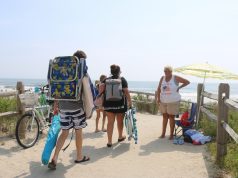
This is a railroad story. It took place a short distance outside Sea Isle, and the conflict briefly jeopardized rail service to the city and points south.
The events give an idea of the rough and sometimes violent life of a railroader in the late 19th century, and of the fierce competition between two railroad giants at the time.
There were at least 11 frog wars between 1853 and 1897. The one at Woodbine Junction was considered a classic.
What’s a Railroad “Frog”?
Railroad frogs have nothing to do with those little tailless web-footed creatures that jump about in the night.
The frogs in question are actually metallic creatures used when one railroad track crosses or joins another.
This kind of frog resembles, and is named after, the triangular horny pad of a horse’s hoof, which is also called a “frog.”
What’s a “Frog War?”
When a frog is installed to cross one track over another, and both tracks belong to the same railroad, there’s no problem.
But when they’re competing railroads, things can get a little testy. This can lead to a conflict called a “frog war.”
And one of the nastiest took place in 1894 at Woodbine Junction – a key part of the West Jersey rail line which fed into Sea Isle City.
Where was Woodbine Junction?
It was on the eastern outskirts of Woodbine and is still shown on Google Maps. The early map indicates the rail crossing that caused all the trouble.
On the map, the West Jersey line passed through Mt. Pleasant on its way to Sea Isle.
What happened at Woodbine Junction in 1894?
The Build-up:
In the early 1890s, the Reading Company decided to extend its reach to the Jersey Shore south of Atlantic City all the way to Cape May.
But to do this, their carrier, the Cape May Railroad, had to cross the tracks of the Pennsylvania-controlled West Jersey Railroad line at Woodbine Junction.
The Cape May had already built track up to the proposed crossing and three miles beyond to Dennisville. This naturally upset the opposing West Jersey contingent.
At first, there was an attempt to adjudicate the issue where the court decided that the Cape May couldn’t cross the West Jersey line at ground level, but instead must build a bridge over the tracks.
Neither side liked this.
The West Jersey, which already ran to Cape May, didn’t want any competition – bridge or no bridge. The Cape May was not happy with the delays attendant with the temporary injunction.
So, nothing was really settled.

This Means “Frog War”
About a week passed. Then the Cape May Railroad decided to act. One night in April 1894, a train carrying about 50 of their laborers approached the junction. Half were there to unload and install a frog.
The other half were armed with ax handles and clubs to ward off any interference.
But the West Jersey force hadn’t been idle. They had stationed about 100 men at Belleplain to be prepared for incursion on their property.
They rushed to the scene by train and positioned the locomotive squarely on the track where the frog was to be laid.
The Cape May Railroad laborers countered this ploy by sending to Tuckahoe for curved rails to get around the West Jersey blockade, but they never got to install it.
As one source (reference 1) put it, “A violent engagement ensued,” with attendant bloodshed. A second source (reference 2), however, states that “When the conflict started to become dangerous, the West Jersey men laid down their shovels and refused to fight.”
No matter how it happened, the Cape May forces must have won out, because the frog ended up being installed.

An earlier frog war took place in Hopewell, N.J. in 1876 (reference 3).
The scene is very similar to that of the war at Woodbine Junction, including the same two major combatants – the Pennsylvania and the Reading Railroads.
Woodbine was history repeating itself.
The Aftermath:
The West Jersey folks didn’t go quietly. They accused the Cape May crew of disorderly conduct, and assault and battery.
The day after the conflict, a Justice of the Peace found a convenient nearby boxcar, set up shop, heard the case, and declared the Cape May defendants guilty.
This precipitated a near riot by the attending crowd.
The justice then prudently and swiftly reversed himself and dismissed all charges to the cheers of the gathered onlookers.
The West Jersey Railroad still wasn’t about to give up. They went to court again and were awarded a judgment to the effect that the frog could remain only until a separate crossing could be built.
In one way, this wasn’t much of a victory for the West Jersey folks because it meant that the Cape May Railroad could immediately begin to move Reading passengers to Cape May – its objective all along.
But in another way, the West Jersey had the last laugh because the Reading line to Cape May never made any money.
So, the Great Frog War of 1894 ended with a whimper, and nobody croaked.
To browse through photos and literature of early Sea Isle and its surroundings, visit the Sea Isle City Historical Museum at 48th Street and Central Avenue. Access the website at www.seaislemuseum.com or call 609-263-2992 with any questions.
Current hours are 10 a.m. to 3 p.m. Monday, Tuesday, Thursday, and Friday. Beginning May 1, Saturday hours will be from 10 a.m. to 1 p.m. and Monday evening hours will be 6 p.m. to 8 p.m.
Special thanks go to Sea Isle City Historical Society volunteer Bob Thibault for writing this Spotlight on History.
Residents and visitors are encouraged to explore the countless photos and artifacts on display inside the Sea Isle City Historical Museum, located on the first level of the Sea Isle City Library at 4800 Central Avenue.








